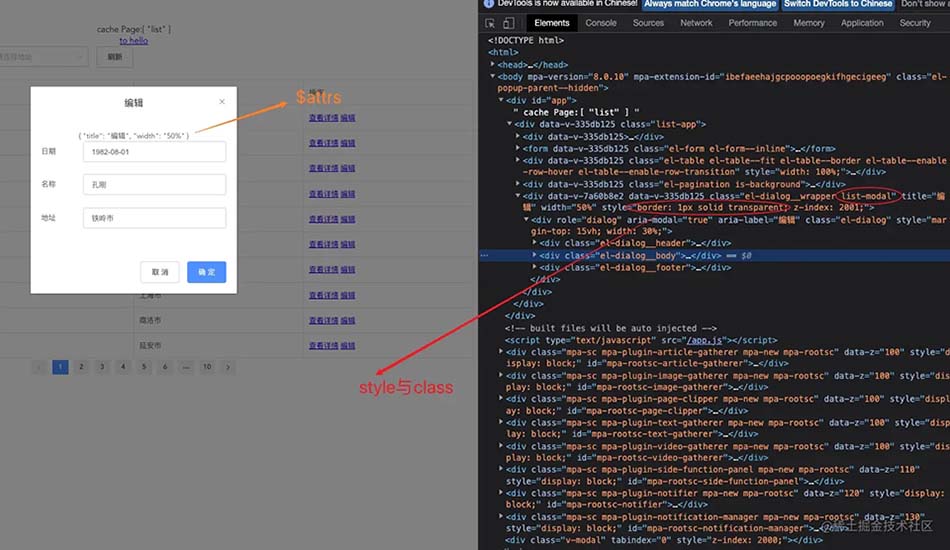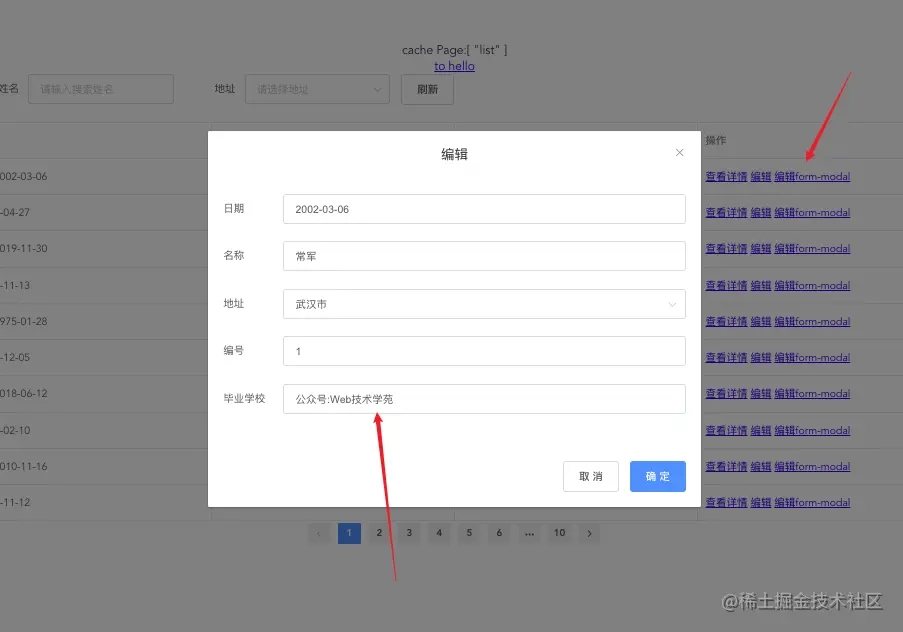vue二次封装高频可复用组件
Maic 人气:0前言
在我们的业务里,我们通常会二次封装一些高频业务组件,比如弹框,抽屉,表单等这些业务组件,为什么要二次封装?我们所有人心里的答案肯定是,同样类似的代码太多了,我想复用组件,或者原有组件可能达不到我想要的效果,我想基于原有组件自定义一些自己的接口,那么此时就需要二次封装了。二次封装虽好,但同时也会带来一定的心智负担,因为二次封装的组件可能会变得不那么纯粹。
本文是一篇笔者关于二次封装组件的思考,希望看完在项目中有所思考和帮助。
正文开始...
在内容开始之前,本文主要从以下几个方向去思考:
1、二次组件必须继承原有组件的所有特性
2、二次组件名必须见名知意
3、自定义暴露出来的接口越简单越好
4、留有自定义插槽,让用户可以自己选择
5、封装二次的组件,能根据schame数据配置,让组件更通用
继承原有组件接口
在之前的项目例子中,我们以一个弹框组件为例
我们看下在业务中一般是怎么写的
<template>
<div class="list-app">
<div><a href="javascript:void(0)" rel="external nofollow" @click="handleToHello">to hello</a></div>
...
<list-modal
title="编辑"
width="50%"
v-model="formParams"
:visible.sync="dialogVisible"
@refresh="featchList"
></list-modal>
</div>
</template>
<script>
import { sourceDataMock } from '@/mock';
import ListModal from './ListModal';
export default {
name: 'list',
components: {
ListModal,
},
...
};
</script>我们再继续看下list-modal这个组件
<!--ListModal.vue-->
<template>
<el-dialog
:visible.sync="currentVisible"
width="30%"
v-bind="$attrs"
>
<el-form label-position="left" label-width="80px" :model="formParams">
<el-form-item label="日期">
<el-input v-model="formParams.date"></el-input>
</el-form-item>
<el-form-item label="名称">
<el-input v-model="formParams.name"></el-input>
</el-form-item>
<el-form-item label="地址">
<el-input v-model="formParams.address"></el-input>
</el-form-item>
</el-form>
<span slot="footer" class="dialog-footer">
<el-button @click="closeModal">取 消</el-button>
<el-button type="primary" @click="handleSure">确 定</el-button>
</span>
</el-dialog>
</template>我们会发现,这个list-modal业务组件只是包了一层,当我们使用v-bind="$attrs"时,vue提供的这个api会将父组件所有的props继承,官方给了一大段解释
- $attrs
包含了父作用域中不作为 prop 被识别 (且获取) 的 attribute 绑定 (class 和 style 除外)。当一个组件没有声明任何 prop 时,这里会包含所有父作用域的绑定 (class 和 style 除外),并且可以通过 v-bind="$attrs" 传入内部组件——在创建高级别的组件时非常有用。
首先我们思考为什么要用这个$attrs?上面一段话的意思是,父组件class与style会排除

我们从页面上可以看出title与width都是父组件传过来的,但是我们发现,实际上这两个外部看似自己传入的props也是el-dialog的props,所以说我们必须要保持自己二次封装的组件也有el-dialog所有能力,所以此时v-bind='$attrs'就可以做到了
- $listeners
包含了父作用域中的 (不含 .native 修饰器的) v-on 事件监听器。它可以通过 v-on="$listeners" 传入内部组件——在创建更高层次的组件时非常有用。
在以上的$attrs我们是将父级的所有的props都拿到了,但是自定义事件呢,所以才有的了$listeners
所以你在父组件写了一个el-dialog的自定义事件想要生效,那么必须在子组件绑定$listeners
<!--list/ListModal.vue-->
<el-dialog
:visible.sync="currentVisible"
width="30%"
v-bind="$attrs"
v-on="$listeners"
>
...
</el-dialog>正常来说一个高阶二次组件必须要有v-bind="$attrs"与v-on="$listeners"
另外我们自己封装的二次组件里有v-model='formParams'
这个formParams就是我们弹框内部表单的使用内容
v-model
关于v-model实际上官方解释就是用在组件或者表单上创建双向绑定,如果把v-model看成是一个内部提供的一个语法糖,那么它可以拆解成:value="value"与:input=“handleInput”,v-model不仅仅是可以作用在表单元素上,并且还可以作用在组件上,同时也提供了一个model的接口,提供自定义修改事件名称
<script>
export default {
name: 'list-modal',
model: {
prop: 'formParams',
event: 'change',
},
props: {
visible: {
type: Boolean,
default: false,
},
formParams: {
type: Object,
},
},
data() {
return {
currentVisible: false,
};
},
watch: {
visible(bool) {
this.currentVisible = bool;
},
currentVisible(bool) {
this.$emit('update:visible', bool);
},
}
};
</script>以上代码就自定义了model的event,prop就是formParams,同时props上必须有引入formParams
不知道你有没有好奇,为啥我data中定义了一个currentVisible,而且watch了visible与currentVisible,使用currentVisible时,这里是有一个坑,因为弹框的icon关闭操作不会触发最外层事件,也就是你点击右上角的关闭操作后,当你再次打开时,此时,就打不开了,所以就没直接用visible了,我们需要另一个变量,然后去watch最终达到我们需要的效果。
在这里有人会奇怪,传入子组件的formParams直接在表单上使用了,嘿,这样不是直接修改props吗,但实际上控制台并不会报错,如果你父组件传入的是一个基础数据类型,你在子组件里修改是会直接警告你不能修改的,但是你传入的是一个对象,你此时修改的是对象属性值,并没有修改原对象,所以一个非基础数据类型数据,修改内部值时,是不会警告的,这样做也是ok的。
插槽
在这个弹框中的确认和取消操作是用插槽slot="footer"去显示的,如果你想自定义插槽,那么你可以通过具名插槽进行兼容处理
<el-dialog
:visible.sync="currentVisible"
width="30%"
v-bind="$attrs"
v-on="$listeners"
>
...
<template v-if="$slots.footer">
<slot name="footer" />
</template>
<span v-else slot="footer" class="dialog-footer">
<el-button @click="closeModal">取 消</el-button>
<el-button type="primary" @click="handleSure">确 定</el-button>
</span>
</el-dialog>在我们的业务中有大量这样的XXXModal弹框,如果我们只是这样包了一层,那么我们只是完成了组件的基本使用,也是符合我们常规业务需求,但是你会发现,我们绝大部份业务里的弹框内容都是表单,所以我能不能通过可配置的schame数据去配置出来呢?
组件更抽象
我们在components下新建了一个form-modal组件,并注册成全局组件,我的目标是把弹框的内容区域做成可配置化,这样我只需要用配置数据就可以渲染出对应的内容
<!--src/components/form-modal/view/index.vue-->
<template>
<div class="form-modal">
<el-dialog :visible.sync="currentVisible" v-bind="$attrs" v-on="$listeners">
<el-form v-bind="formConfig.formAttrs" :model="formParams">
<div v-for="(item, index) in formConfig.fields" :key="index">
<el-form-item :label="item.label">
<!--自定义插槽-->
<template v-if="item.slot">
<slot :name="item.slot" :row="{ ...item, formParams, index }" />
</template>
<!--文本or文本域-->
<template v-else-if="['text', 'textarea'].includes(item.type)">
<el-input
:type="item.type"
v-bind="item.attrs || {}"
v-model="formParams[item.key]"
></el-input>
</template>
<!--下拉框-->
<template v-else-if="item.type === 'select'">
<el-select v-bind="item.attrs" v-model="formParams[item.key]">
<el-option
v-for="(sitem, index) in item.options.data"
:key="index"
:label="sitem[item.options.extraProps.label]"
:value="sitem[item.options.extraProps.value]"
>
</el-option>
</el-select>
</template>
</el-form-item>
</div>
</el-form>
<span slot="footer" class="dialog-footer">
<el-button @click="closeModal">取 消</el-button>
<el-button type="primary" @click="handleSure">确 定</el-button>
</span>
</el-dialog>
</div>
</template>全局注册
// src/components/index.js
import Vue from 'vue';
import FormModal from './form-modal';
const custCompoment = {
FormModal,
};
export const installCustComponent = () => {
Object.keys(custCompoment).forEach((key) => {
Vue.component(key, custCompoment[key]);
});
};main.js
// main.js
import { installCustComponent } from '@/components';
installCustComponent();
...我们发现在模版里面有不少添加条件,实际上,这些条件主要根据你业务需要而定,除了模版方式,插槽,我们也可以预留一个自定义formater的接口,像下面这样
<!--src/components/form-modal/view/index.vue-->
<div v-for="(item, index) in formConfig.fields" :key="index">
<el-form-item :label="item.label">
<!--自定义render-->
<template v-if="item.formater">
<component
:is="'renderComponent'"
:value="formParams[item.key]"
:input="e => formParams[item.key] = e"
v-bind="{ ...item }"
></component>
</template>
<!--自定义插槽-->
<template v-else-if="item.slot">
<slot :name="item.slot" :row="{ ...item, formParams, index }" />
</template>
<!--文本or文本域-->
...
</el-form-item>
</div>那么此时你会发现有一个renderComponent这样的自定义组件,我们必须引入进来
/* src/components/form-modal/view/render.js*/
export default {
functional: true,
props: ['value'],
render(h, ctx) {
const { formater, attrs, input: handleInput } = ctx.data.attrs;
return formater(h, {
attrs: {
...attrs,
value: ctx.props.value,
},
on: {
input(e) {
handleInput(e);
},
},
});
},
};在form-modal/view/index.vue中我们必须引入,所以模版中就可以使用了
<script>
// src/components/form-modal/view/index.vue
import renderComponent from './render';
export default {
name: 'form-modal',
model: {
prop: 'formParams',
event: 'change',
},
components: {
renderComponent,
},
props: {
visible: {
type: Boolean,
default: false,
},
formParams: {
type: Object,
},
formConfig: {
type: Object,
},
},
...
</script>我们再看下我们之前业务弹框与schame再次抽象后的两个组件,其实第二个全局组件就多了一个formConfig属性,我们统一把内容抽离了出去,我们的form-modal就变得更加通用,我们只需要关注formConfig这份配置数据就行
/* eslint-disable func-names */
<template>
<div class="list-app">
...
<list-modal
title="编辑"
width="50%"
class="list-modal"
style="border: 1px solid transparent"
v-model="formParams"
:visible.sync="dialogVisible"
@refresh="featchList"
@close="handleClose"
>
<div slot="footer">确定</div>
</list-modal>
<form-modal
title="编辑"
width="50%"
class="list-modal"
style="border: 1px solid transparent"
v-model="formParams"
:formConfig="formConfig"
:visible.sync="dialogVisible2"
@refresh="featchList"
@close="handleClose"
>
<template slot-scope="{ row }" slot="number">
<el-input
:type="row.type"
v-bind="row.attrs || {}"
v-model="row.formParams[row.slot]"
></el-input>
</template>
</form-modal>
</div>
</template>
<script>
import { sourceDataMock } from '@/mock';
import ListModal from './ListModal';
export default {
name: 'list',
components: {
ListModal,
},
data() {
return {
...
tableData: [],
dialogVisible: false,
dialogVisible2: false,
formParams: {
date: '',
name: '',
address: '',
number: '1',
scholl: '公众号:Web技术学苑',
},
};
},
computed: {
formConfig() {
return {
formAttrs: {
labelWidth: '80px',
labelPosition: 'left',
},
fields: [
{
type: 'text',
key: 'date',
label: '日期',
attrs: {
placeholder: '请填写日期',
},
},
{
type: 'text',
key: 'name',
label: '名称',
attrs: {
placeholder: '请填写名称',
},
},
{
type: 'select',
key: 'address',
label: '地址',
attrs: {
placeholder: '请选择地址',
style: {
width: '100%',
},
},
options: {
data: this.tableData,
extraProps: {
value: 'address',
label: 'address',
},
},
},
{
type: 'text',
slot: 'number',
label: '编号',
attrs: {
placeholder: '请输入编号',
},
},
{
type: 'text',
key: 'scholl',
label: '毕业学校',
attrs: {
placeholder: '请输入毕业学校',
},
formater: (h, props) =>
h('el-input', {
...props,
}),
},
],
};
},
},
};
</script>
<style scoped>
.list-app .el-form {
text-align: left;
}
</style>看下最终的结果

在我们自定义一个formater的接口,我们注意到,实际上这里有用vue的纯函数组件,我们注意到在render.js中我们是申明了functional: true,这里会有巨坑,如果是一个函数组件,在render函数中是获取不到this的,只能通过第二个ctx参数获取父组件传入的props信息
/* eslint-disable no-param-reassign */
export default {
functional: true,
props: ['value'],
render(h, ctx) {
// console.log(this, '---'); // 会是null,只能通过第二个参数ctx拿对应参数
const { formater, attrs, input: handleInput } = ctx.data.attrs;
return formater(h, {
attrs: {
...attrs,
value: ctx.props.value,
},
on: {
input(e) {
handleInput(e);
},
},
});
},
};并且我们修改数据,我们发现我们用了一个父组件传入的一个回调函数去修改,这在react很常见,这里我们也是通过回调方式修改数据,因为vue数据流是单向的,所以只能这种方式去修改了
因此在业务中我们的form-modal就变得更通用,更高频了,这样会减少你重复劳动的时间,你只需要关注配置接口信息就行。
但是这样带来的负担是有的,如果这个form-modal耦合了太多业务逻辑,那么带来的心智负担是有的,当你二次封装的一个高频组件,你组内小伙伴不能像使用第三方组件库那么快捷时,说明组件的接口设计还有提高的空间,判断一个组件好不好用的标准就是,零负担,而且人人能改,人人都能改动,如果因为业务特殊,当我们考虑二次封装一个组件参杂很多业务逻辑判断时,那我的观点是,还是不要进行二次封装了。
总结
以一个弹框组件为例,我们二次封装组件到底需要注意哪些问题,以及我们必须注意些什么,核心思想就是继承原有组件的特性,
v-bind='$attrs'与v-on="$listeners"是核心当我们二次封装一个组件时,我们自定义的一些接口能少就少,组件名必须见名知意
二次封装的组件不仅仅只是包一层,我们可以尝试用数据配置方式让组件更通用,预留一些接口插槽,或者自定义
formater函数,不强制约束,让组件灵活性拓展性更强些组件的
props名字尽量不要带来负担,最好与原有组件props保持一致本文 code example
加载全部内容